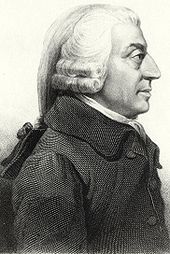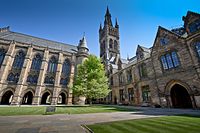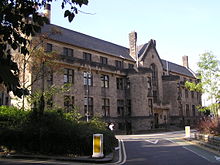University Of Glasgow
The University of Glasgow (abbreviated as Glas. in post-nominals; Scottish Gaelic: Oilthigh Ghlaschu) is a public research university in Glasgow, Scotland. Founded by papal bull in 1451 [O.S. 1450], it is the fourth-oldest university in the English-speaking world and one of Scotland's four ancient universities. Along with the universities of St Andrews, Aberdeen, and Edinburgh, the university was part of the Scottish Enlightenment during the 18th century. Glasgow is the largest university in Scotland by total enrolment and, with over 15,900 postgraduates, the fifth-largest in the United Kingdom by postgraduate enrolment.
In common with universities of the pre-modern era, Glasgow originally educated students primarily from wealthy backgrounds; however, it became a pioneer in British higher education in the 19th century by also providing for the needs of students from the growing urban and commercial middle class. Glasgow University served all of these students by preparing them for professions: law, medicine, civil service, teaching, and the church. It also trained smaller but growing numbers for careers in science and engineering. Glasgow has the fifth-largest endowment of any university in the UK and the annual income of the institution for 2023–24 was £950 million of which £221.1 million was from research grants and contracts, with an expenditure of £658.6 million. It is a member of Universitas 21, the Russell Group and the Guild of European Research-Intensive Universities.
The university was originally located in the city's High Street; since 1870, its main campus has been at Gilmorehill in the City's West End. Additionally, a number of university buildings are located elsewhere, such as the Veterinary School in Bearsden, and the Crichton Campus in Dumfries.
The alumni of the University of Glasgow include some of the major figures of modern history, including James Wilson, a signatory of the United States Declaration of Independence, 3 Prime Ministers of the United Kingdom (William Lamb, Henry Campbell-Bannerman and Bonar Law), 3 Scottish First Ministers (Humza Yousaf, Nicola Sturgeon and Donald Dewar), economist Adam Smith, philosopher Francis Hutcheson, engineer James Watt, physicist Lord Kelvin, surgeon Joseph Lister along with 4 Nobel Prize laureates (in total 8 Nobel Prize winners are affiliated with the University) and numerous Olympic gold medallists, including the current chancellor, Dame Katherine Grainger.
History
The University of Glasgow was founded in 1451 by a charter or papal bull from Pope Nicholas V, at the suggestion of King James II, giving Bishop William Turnbull, a graduate of the University of St Andrews, permission to add a university to the city's Cathedral. It is the second-oldest university in Scotland after St Andrews and the fourth-oldest in the English-speaking world. The universities of St Andrews, Glasgow, and Aberdeen were ecclesiastical foundations, while Edinburgh was a civic foundation. As one of the ancient universities of the United Kingdom, Glasgow is one of only eight institutions to award undergraduate master's degrees in certain disciplines.
The university has been without its original Bull since the mid-sixteenth century. In 1560, during the political unrest accompanying the Scottish Reformation, the then chancellor, Archbishop James Beaton, a supporter of the Marian cause, fled to France. He took with him, for safe-keeping, many of the archives and valuables of the cathedral and the university, including the Mace and the Bull. Although the Mace was sent back in 1590, the archives were not. Principal James Fall told the Parliamentary Commissioners of Visitation on 28 August 1690, that he had seen the Bull at the Scots College in Paris, together with the many charters granted to the university by the monarchs of Scotland from James II to Mary, Queen of Scots. The university enquired of these documents in 1738 but was informed by Thomas Innes and the superiors of the Scots College that the original records of the foundation of the university were not to be found. If they had not been lost by this time, they certainly went astray during the French Revolution when the Scots College was under threat. Its records and valuables were moved for safe-keeping out of the city of Paris. The Bull remains the authority by which the university awards degrees.
Teaching at the university began in the Chapter House of Glasgow Cathedral, subsequently moving to nearby Rottenrow, in a building known as the "Auld Pedagogy". The university was given 13 acres (5.3 ha) of land belonging to the Black Friars (Dominicans) on High Street by Mary, Queen of Scots, in 1563. By the late 17th century its building centred on two courtyards surrounded by walled gardens, with a clock tower, which was one of the notable features of Glasgow's skyline—reaching 140 feet (43 m) in height—and a chapel adapted from the church of the former Dominican (Blackfriars) friary. Remnants of this Scottish Renaissance building, mainly parts of the main façade, were transferred to the Gilmorehill campus and renamed as the "Pearce Lodge", after Sir William Pearce, the shipbuilding magnate who funded its preservation. The Lion and Unicorn Staircase was also transferred from the old college site and is now attached to the Main Building.
John Anderson, while professor of natural philosophy at the university, and with some opposition from his colleagues, pioneered vocational education for working men and women during the Industrial Revolution. To continue this work in his will, he founded Anderson's College, which was associated with the university before merging with other institutions to become the University of Strathclyde in 1964.
In 1973, Delphine Parrott became its first female professor, as Gardiner Professor of Immunology.
In October 2014, the university court voted for the university to become the first academic institution in Europe to divest from the fossil fuel industry.
Campus
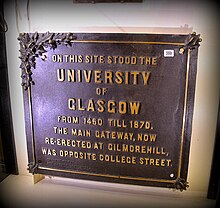
The university is currently spread over a few campuses. The main one is the Gilmorehill campus, in Hillhead. As well as this there is the Garscube Estate in Bearsden, housing the Veterinary School, Observatory, ship model basin and much of the university's sports facilities, the Dental School in the city center, the section of Mental Health and Well Being at Gartnavel Royal Hospital on Great Western Road, the Teaching and Learning Centre at the Queen Elizabeth University Hospital and the Crichton Campus in Dumfries (operated jointly by the University of Glasgow, the University of the West of Scotland and the Open University).
The Imaging Centre of Excellence (ICE) was opened at the Queen Elizabeth University Hospital on 29 March 2017, including a Clinical Innovation Zone spanning 11,000 square feet (1,000 m) of collaboration space for researchers and industry.
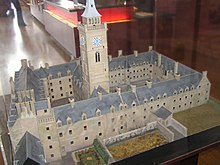
High Street
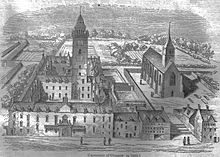
The university's initial accommodation including Glasgow University Library was part of the complex of religious buildings in the precincts of Glasgow Cathedral. In 1460, the university received a grant of land from James, Lord Hamilton, on the east side of the High Street, immediately north of the Blackfriars Church, on which it had its home for the next four hundred years. In the mid-seventeenth century, the Hamilton Building was replaced with a very grand two-court building with a decorated west front facing the High Street, called the 'Nova Erectio', or New Building. This foundation is widely considered to have been one of the finest 17th-century buildings in Scotland. Decorated fragments from it, including a complete exterior stairway, were rescued and built into its 19th-century replacement. In Sir Walter Scott's best-selling 1817 novel Rob Roy, set at the time of the Jacobite rising of 1715, the lead character fights a duel in the New Building grounds before the contest is broken up by Rob Roy MacGregor.

Over the following centuries, the university's size and scope continued to expand. In 1757 it built the Macfarlane Observatory and later Scotland's first public museum, the Hunterian. It was a center of the Scottish Enlightenment and subsequently of the Industrial Revolution, and its expansion in the High Street was constrained. The area around the university declined as well-off residents moved westwards with the expansion of the city and overcrowding of the immediate area by less well-off residents. It was this rapid slumming of the area that was a chief catalyst of the university's migration westward.
Gilmorehill
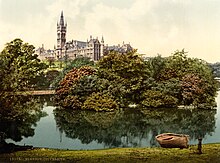
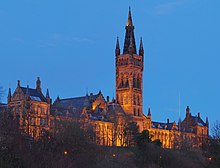
In 1870, the university moved to a (then greenfield) site on Gilmorehill in the West End of the city, around three miles (five kilometres) west of its previous location, enclosed by a large meander of the River Kelvin. The original site on the High Street was sold to the City of Glasgow Union Railway and replaced by the college goods yard. The new-build campus was designed by Sir George Gilbert Scott in the Gothic revival style. The largest of these buildings echoed, on a far grander scale, the original High Street campus's twin-quadrangle layout, and may have been inspired by Ypres' late-medieval cloth hall; Gilmorehill, in turn, inspired the design of the Clocktower complex of buildings for the new University of Otago in New Zealand. In 1879, Gilbert Scott's son, Oldrid, completed this original vision by building an open undercroft forming two quadrangles, above which is his grand Bute Hall (used for examinations and graduation ceremonies), named after its donor, John Crichton-Stuart, 3rd Marquess of Bute. Oldrid also later added a spire to the building's signature gothic bell tower in 1887, bringing it to a total height of some 85 metres (278 ft). The local Bishopbriggs blond sandstone cladding and Gothic design of the building's exterior belie the modernity of its Victorian construction; Scott's building is structured upon what was then a cutting-edge riveted iron frame construction, supporting a lightweight wooden-beam roof. The building also forms the second-largest example of Gothic revival architecture in Britain, after the Palace of Westminster. An illustration of the Main Building previously featured on the reverse side of £100 notes issued by Clydesdale Bank.
The university's Hunterian Museum resides in the Main Building, and the related Hunterian Gallery is housed in buildings adjacent to the University Library. The latter includes "The Mackintosh House", a rebuilt terraced house designed by, and furnished after, architect Charles Rennie Mackintosh.
Even these enlarged premises could not contain the expanding university, which quickly spread across much of Gilmorehill. The 1930s saw the construction of the award-winning round Reading Room (it is now a category-A listed building) and an aggressive program of house purchases, in which the university (fearing the surrounding district of Hillhead was running out of suitable building land) acquired several terraces of Victorian houses and joined them together internally. The departments of Psychology, Computing Science, and most of the Arts Faculty continue to be housed in these terraces.
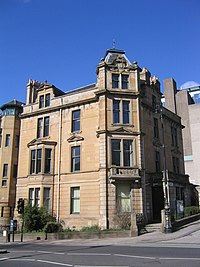
More buildings were built to the west of the Main Building, developing the land between University Avenue and the River Kelvin with natural science buildings and the faculty of medicine. The medical school spread into neighboring Partick and joined with the Western Infirmary. At the eastern flank of the Main Building, the James Watt Engineering Building was completed in 1959. The growth and prosperity of the city, which had originally forced the university's relocation to Hillhead, again proved problematic when more real estate was required. The school of veterinary medicine, which was founded in 1862, moved to a new campus in the leafy surrounds of Garscube Estate, around two miles (3 km) west of the main campus, in 1954. The university later moved its sports ground and associated facilities to Garscube and also built student halls of residence in both Garscube and Maryhill.
The expected growth of tertiary education in the 1960s following publication of the Robbins Report led the university to build numerous modern buildings across Hillhead in a development zone, originally comprising mainly residential tenements, that had been designated on the north side of University Avenue in 1945. Several of these new buildings were in the brutalist style; the Mathematics Building at the west end of University Avenue (opened 1968, demolished 2017), the Rankine Building at the east end of University Avenue (opened 1970), the multipurpose Adam Smith Building (opened 1967) on the crest of the hill above University Gardens, and the new Queen Margaret Union building (opened 1968) on the University Gardens site previously occupied by the University Observatory. These were joined by others in various modernist styles; both the Library and Boyd Orr Building (opened 1968 and 1972 respectively) were configured as tower blocks, as was the Genetics Building at the very south end of the campus on Dumbarton Road (opened 1967, named for Guido Pontecorvo in 1994, demolished 2021), while the amber-brick Geology Building (opened 1980, named for John Walter Gregory in 1998, renamed for Silas Molema in 2021) was built to a low-rise design on the former site of eight terraced houses in Lilybank Gardens.
To further cater to the expanding student population, a new refectory—known as the Hub—was opened adjacent to the library in 1966, and the Glasgow University Union building at the eastern end of University Avenue was extended in 1965.
In October 2001 the century-old Bower Building (previously home to the university's botany department) was gutted by fire. The interior and roof of the building were largely destroyed, though the main façade remained intact. After a £10.8 million refit, the building re-opened in November 2004.
The Wolfson Medical School Building, with its award-winning glass-fronted atrium, opened in 2002, and in 2003, the St Andrews Building was opened, housing what is now the School of Education. It is sited a short walk from Gilmorehill, in the Woodlands area of the city on the site of the former Queens College, which had in turn been bought by Glasgow Caledonian University, from whom the university acquired the site. It replaced the St Andrews Campus in Bearsden. The university also procured the former Hillhead Congregational Church, converting it into a lecture theatre in 2005. The Sir Alwyn Williams building, designed by Reiach and Hall, was completed at Lilybank Terrace in 2007, housing the School of Computing Science.
In September 2016, in partnership with Glasgow City Council, Glasgow Life, and the National Library of Scotland, the transformed Kelvin Hall was brought into new public use including in Phase I the Hunterian Collections and Study Centre.
The Mathematics Building, on University Way adjacent to the Boyd Orr Building, was demolished in 2017 to make way for a new 'Learning Hub' intended to provide individual and group study spaces for more than 2,500 students, as well as a 500-seat lecture theatre. Built at a cost of £90.6 million, it opened in April 2021 and is named for James McCune Smith, the first African American to earn a degree in medicine and a University of Glasgow alumnus. A further investment of over £900 million is being made across the Gilmorehill campus, focused mainly on redeveloping the 5.7-hectare (14-acre) site between University Avenue and Dumbarton Road that was occupied by the Western Infirmary between 1874 and 2015.
Chapel
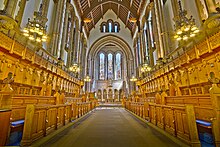
The University Chapel was constructed as a memorial to the 755 sons of the university who had died in the First World War. Designed by Sir John Burnet, it was completed in 1929 and dedicated on 4 October. Tablets on the wall behind the Communion Table list the names of those who died, while other tablets besides the stalls record the 405 members of the university community who gave their lives in the Second World War. Most of the windows are the work of Douglas Strachan, although some have been added over the years, including those on the South Wall, created by Alan Younger.
Daily services are held in the chapel during term-time, as well as seasonal events. Before Christmas, there is a Service of Nine Lessons and Carols on the last Sunday of term, and a Watchnight service on Christmas Eve. Graduates, students, members of staff, and the children of members of staff are entitled to be married in the chapel, which is also used for baptisms and funerals. Civil marriages and civil partnerships may be blessed in the chapel, although under UK law may not be performed there.
The current chaplain of the university is the Reverend Stuart MacQuarrie, and the university appoints honorary chaplains of other denominations.
Library and archives
This article contains promotional content. (June 2024) |
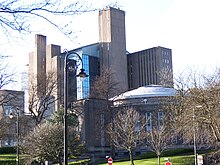
The University Library, situated on Hillhead Street opposite the Main Building, is one of the oldest and largest libraries in Europe. Situated over 12 floors, it hosts more than three million books and journals, and provides electronic resources, including over 51,900 electronic journals. It also houses sections for periodicals, microfilms, special collections and rare materials. The Library is open between 7 a.m. and 2 a.m., 361 days of the year.
In addition to the main library, subject libraries exist for Medicine, Chemistry, Dental Medicine, Veterinary Medicine, Education, Law, History of Art, and the faculty of Social Sciences, which are held in branch libraries around the campus. In 2007, a state-of-the-art section to house the library's collection of historic photographs was opened, funded by the Wolfson Foundation.
The Archives of the University of Glasgow is the central place of deposit for the records of the university, created and accumulated since its foundation in 1451.
Crichton campus, Dumfries
The university opened the Crichton campus in Dumfries, Dumfries and Galloway during the 1980s. It was designed to meet the needs for tertiary education in an area far from major cities and is operated jointly by the University of Glasgow, the University of the West of Scotland and the Open University. It offers a modular undergraduate curriculum, leading to one of a small number of liberal arts degrees, as well as providing the region's only access to postgraduate study.
Non-teaching facilities
As well as these teaching campuses the university has halls of residence in and around the North-West of the city, accommodating a total of approximately 3,500 students. These include the Murano Street Student Village in Maryhill; Wolfson halls on the Garscube Estate; Queen Margaret halls, in Kelvinside; Cairncross House and Kelvinhaugh Gate, in Yorkhill. In recent years, Dalrymple House and Horslethill halls in Dowanhill, Reith halls in North Kelvinside and the Maclay halls in Park Circus (near Kelvingrove Park), have closed and been sold, as the development value of such property increased.
The Stevenson Building on Gilmorehill opened in 1961 and provides students with the use of a fitness suite, squash courts, sauna, and six-lane, 25-metre swimming pool. The university also has a large sports complex on the Garscube Estate, besides their Wolfson Halls and Vet School. This is a new facility, replacing the previous Westerlands sports ground in the Anniesland area of the city. The university also has use of half of the East Boathouse situated at Glasgow Green on the River Clyde where Glasgow University Boat Club train.
Governance and administration
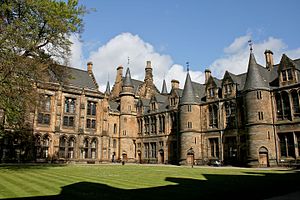
In common with the other ancient universities of Scotland the university's constitution is laid out in the Universities (Scotland) Acts. These Acts create a tripartite structure of bodies: the University Court (governing body), the Academic Senate (academic affairs), and the General Council (advisory). There is also a clear separation between governance and executive administration.
The university's constitution, academic regulations, and appointments are described in the university calendar, while other aspects of its story and constitution are detailed in a separate "history" document.
